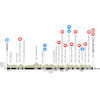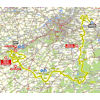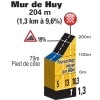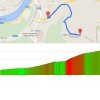The Flèche Wallonne and the Wall of Huy are intertwined. Often the pack attacks the steep final ascent in closed formation. Are we going to see the race unfold differently in 2020?
Possibly, the new finale favours attackers. The Côte de Cherave – 1.3 kilometres at 8.1% – had been removed in favour of the Côte de chemin des Gueuses. This 1.8 kilometres climb at 6.5% lies 11.5 kilometres before the Wall of Huy, which is 6 kilometres further away than the Cherave.
Following the start in Herve, east of Liège, the route winds through the Ardennes. The ascent of the Côte de Trasenster stands out on the flat to undulating roads. Then the riders enter a local circuit of 32 kilometres and shortly the Côte d’Ereffe serves an uphill of 2.1 kilometres at 5%. Following a few kilometres on the flat the route descends to the valley of the Hoyoux river. Almost without respite the 1.8 kilometers climb on the Chemin des Gueuses appears. The first part is very steep.
The riders descent into Huy and zigzag through the town to the foot of the Wall. The 1.3 kilometres climb goes up with an average gradient of 9.6%, yet that statistic is misleading as the 400 metres are nothing special. Then the wall kicks in hard: 400 metres at 11%, 100 metres at 17%, 300 metres at 14% before the last 100 metres level out to 6%.
For years, Alejandro Valverde was the King of La Flèche Wallonne. The Spaniard won the race in 2006 and in the period 2014-2017, while Julian Alaphilippe took over his crown in 2018. He also won in 2019.
Other interesting reads: results and start list of La Flèche Wallonne 2020.
La Flèche Wallonne 2020: route, profiles, more
Click on the images to zoom








